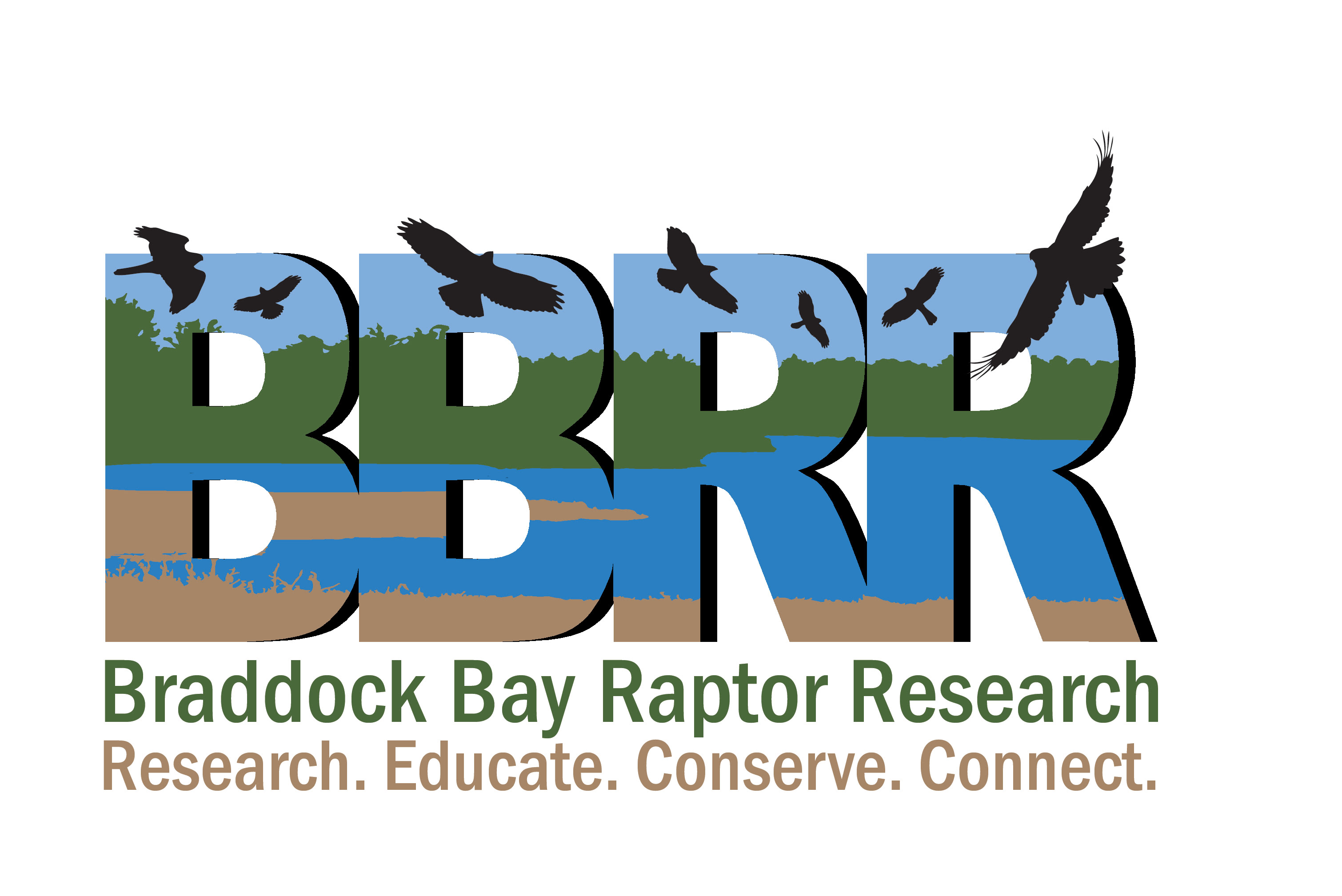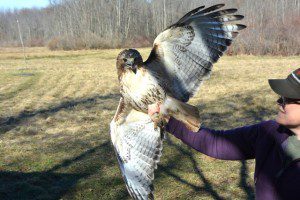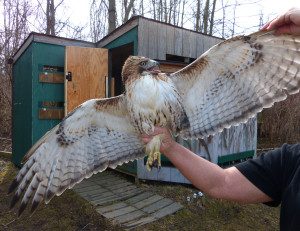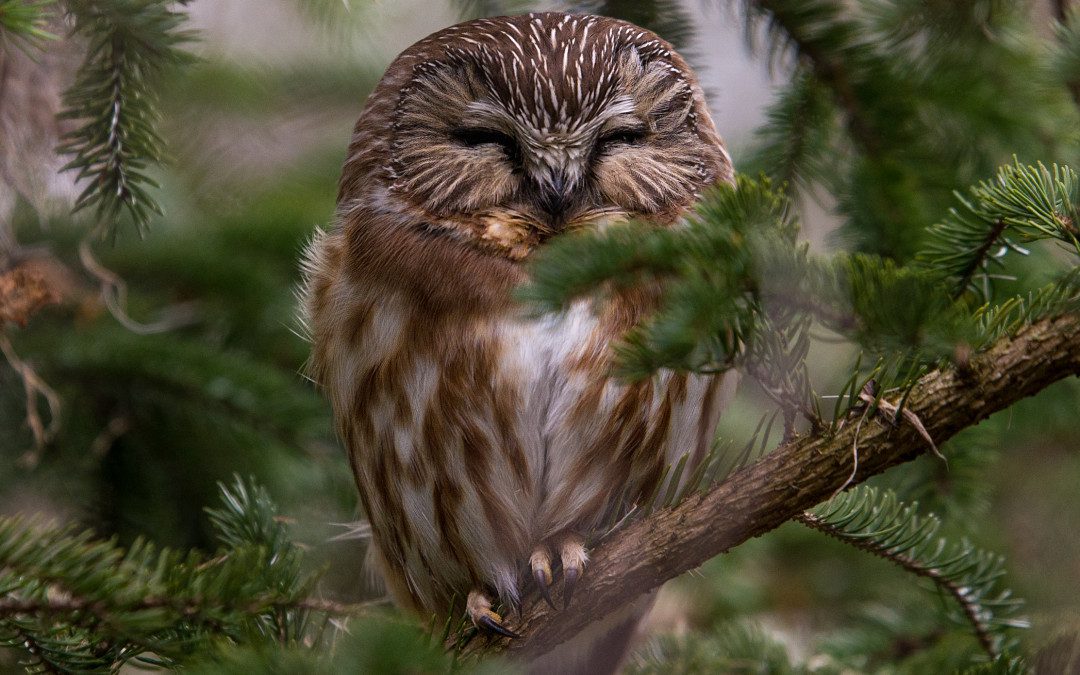
An Owl “Hat-trick”
Each spring, BBRR volunteers survey the Owl Woods for roosting owls that are utilizing the area as a stop over during migration. Information gained from this survey helps is used to monitor the habitat usage by the owls, and in turn helps us to manage and protect the area for the future. While the science behind this data collection is important, no one will deny that it is a true privilege to observe these magical raptors in their natural habitat. Check out our Owl Roost Survey page for more info.
Read on to see just how magical the woods can be at times here at Braddock Bay, and enjoy the account and photos by BBRR volunteer Zaphir Shamma.
On March 25, my wife Tanya and I were surveying for owls in Owl Woods. The day was cold and gray with strong winds. Not the best day to be out, but we were hopeful. As usual, we started out in the “classroom”, then met a man from Canada who said there was a Saw-whet back in the pines. We followed in the general direction of where he pointed and quickly found the spot. We could see a Northern Saw-whet Owl about 8 feet high and tucked deep into the tree. The owl was partially obscured by branches from every angle, but we had nice views of its front. It didn’t appear to be too concerned that we were there, and kept its eyes closed while we viewed it.
We then moved down the path in the direction of the raptor banding station. Tanya wanted to investigate that one large spruce that is off the trail on the right. While searching that area, Tanya reported that she unintentionally flushed “something” and it flew off towards the east. We continued on down the path and rounded the loop. As we began to explore the tall pines on our left, Tanya stopped and said she saw an owl. She pointed about 30 feet off the ground towards a thick pine that was blowing in the wind. The bows were swinging back and forth and finally, I was able to see what she saw (but only for a second). The wind-driven bows would hide, uncover briefly and then re-hide this owl. I took photos as best I could while trying to time the moving branches. While discussing if we should go back and get a better camera lens, the bird pooped, and then bolted silently in a northern direction. It was big and silhouetted, so we couldn’t tell what it was. Once we got home and examined the photos, it turned out not to be a Long-eared Owl as we suspected, rather…it was a Great Horned Owl! We feel that this was the same bird that Tanya had accidentally flushed about 15 minutes earlier.
Tanya and I continued to move back towards the entrance of Owl Woods, searching as we went. Once we got close to where the paths come back together, we came across Jim Saller (BBRR volunteer) who had spotted a Long-eared Owl. We quietly joined him and looked at a beautiful bird high in the canopy. It was dark, back-lit and silhouetted, but the outline was crisp and we knew we had a Long Ear. Photos were taken and we moved on.
All in all, not bad for a gray, cold and windy day. Three different owl species (an Owl Hat-trick) in the woods that we have grown to love.
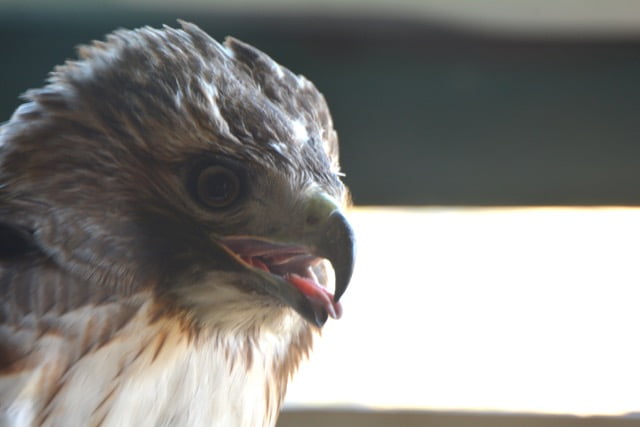
Raptor Banding Update – Careful What You Wish For!
Photo above: Red-tailed Hawk, by Wayne Sheeler
Third week of March 2016, by Barbara French
Report from Main Station:
We love south and southwest winds for hawks. Nothing is better for bringing them right along the lakeshore and right over the banding station, but be careful what you wish for!
The only decent day for banding this week turned out to be Thursday (March 17th, St. Patrick’s Day), so Susie Cotsworth and I headed out for the banding station around 10 AM with high hopes. As it turned out, a couple of matters delayed my getting there by about fifteen minutes, so when I arrived at the station it was to a “Thank God! Here, take this hawk!” as Susie handed me a can-ful of very feisty, large Red-tailed Hawk she had captured right upon opening. We had three rapt visitors watching the spectacle. Susie gave me the hawk for processing so she could turn her attention back to the trapping process. Unfortunately the hawk, a rather large one, was of an awkward neither-nor size – too big for our usual red-tail can, too small for the largest can and nothing suitable in between. I banded her with our largest usual Red-tailed Hawk band, but for safety reasons I didn’t dare weigh her because that would require dropping her legs back into the can. She was a loose fit, and I was afraid once she had room to wiggle, we wouldn’t get her out again without risking serious injury to us (not to her). So after banding, I just pulled her out for the rest of the processing.
Although the skies were absolutely full of birds, we only caught one other adult Red-tailed Hawk before our lovely brisk southwest winds turned into gale force. Not only was it blowing everything around inside the blind, but the smaller birds were being shot off along the lakeshore like they’d been fired out of a cannon! Small accipiters like Sharp-shinned Hawks and Cooper’s Hawks already tend to “pop up” quickly from the trees, giving us little time to respond, but these birds were caught by the wind so quickly that by the time we could react, they were already carried off by the winds beyond their ability to turn around to see what was going on. The winds quickly grew so fierce the few Red-tailed Hawks that were braving the winds seemed reluctant to try to move against them, and soon there were nothing but Turkey Vultures braving the storm from our view.
While we always wish for southwest winds, and stronger ones at that (10-15 miles per hour is about ideal), gusts of 40 mph and up are not conducive to trapping!
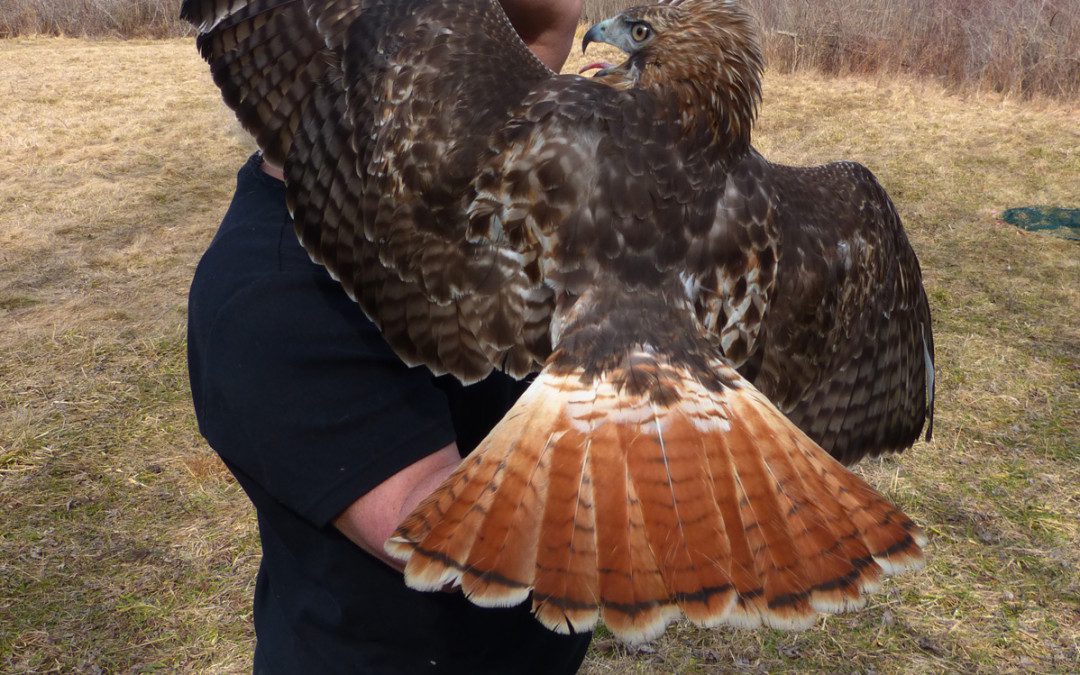
Raptor Banding Update – What a difference a year makes!
Second Week of March 2016, by Barb French
Last year, Susie Cotsworth and I opened Main Blind in the Owl Woods late in March – and we had to dig out a trench in the snow to run lines to the traps. We froze nearly to death on many of those early days! A frozen lake and ripping lake effect winds kept us chilled and the birds away until well into April.
This year, on Tuesday, March 8th, Dan Niven, Susie and I, with the help of Susie’s wonderful husband Tony, opened Main Blind amidst temperatures in the mid-50s, overcast skies, and warm, mild winds. While the field was pretty wet and squishy, little to no snow was in sight. As opposed to bundling up in long underwear, mittens, hat, and hand warmers, I was out this year in a short-sleeved T-shirt installing traps. Joined later by banding trainee Jim Saller, we installed four bow nets and got two fully rigged with lines, returned our cans and tools to the blind, and got everything organized for what we hope to be a much more successful spring hawk banding season. Daena Ford stopped in to deliver needed paperwork and much-appreciated Girl Scout cookies for those who had ordered them, as well as to handle a few items of business.
What we didn’t see were hawks. The promised southwest winds never materialized, replaced instead by light northeastern winds. Geese, swans, and gulls teased us, but we didn’t see our first raptor until Dan spotted a Turkey Vulture on our way to our traditional after-banding lunch at Jo’s Diner.
However, the next day (Wednesday, March 10th) was much more productive. Susie and I saw far more birds than we caught – many Red-tailed Hawks, two nice Rough-legged Hawks, one American Kestrel flitting his way across the field, and several Red-shouldered Hawks, including one so gloriously bold and bright it took our breath away! Visitors were present to see three of our four birds banded that day, all Red-tailed Hawks – two adults and two 2015-hatched juvenile birds.
Saturday (March 12th) looked decent on paper, but a combination of cold, light winds and blue skies sent the birds too high to attract down to earth. One beautiful full-adult Bald Eagle, with glowing white head and tail, graced us with a lower look as it sailed around in the station. Susie and I put the down time to good use to finish running the lines on a third bow trap, so we now have three traps fully operational. Next week will be too rainy for a lot of action, but we’re hoping to get out again when the skies clear up!
